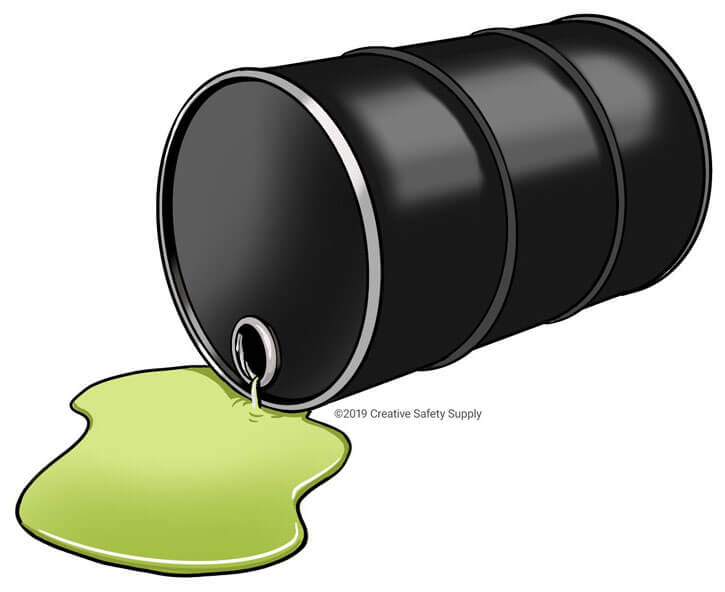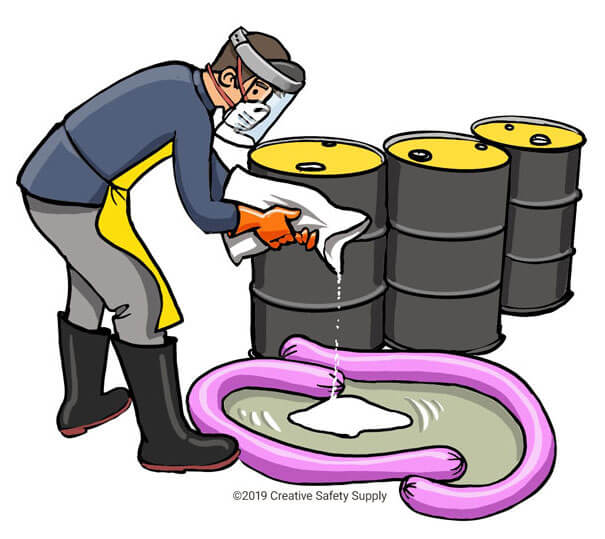
Spills are a common occurrence at many facilities, and the safety of both the work environment and workers depends on an effective and quick response. The best means of preparation is to have the correct cleanup equipment on hand, conduct training on actions to take, and commit to restocking material so your workplace is continually able to handle spills.

To be prepared, standard rolls, pads, other general absorbents, and designated spill kits should be easily accessible and located throughout the facility. This will enable fast spill cleanup during an emergency. Spills can lead to serious injuries, property damage, and negative environmental impact if they reach drains or open water. However, they are preventable as long as employers provide preparation, appropriate materials, and effective training.
What Materials Are Required for Spill Cleanup?
Spill kits are the most common and effective means of cleaning up spills, and there are a wide variety of sizes and choices available. While some are designed for certain spills/substances such as dangerous chemicals, spill kits typically contain these three components:- Personal Protective Equipment. PPE is always incorporated in a spill kit, no matter what type of substance the kit was meant to handle. Common types of PPE in spill kits are shoe covers/booties, gloves, and face/eye protection. Chemical spill kits typically include respirator protection, a disposable lab coat, and an apron that’s corrosive resistant.
- Absorbents. Also known as sorbents, these items include loose powder such as sand, sponges, cloths, pillows, and pads which are made from material that’s able to contain and absorb a spill. Absorbents vary depending on the material they’re intended to soak up. Universal spill kits contain all-purpose or general absorbents, while a battery acid spill kit’s absorbents will involve a chemical neutralizer.
- Cleanup materials. Kits generally include a scoop or dust pan, plastic bags, and instructions. On top of adequate cleanup supplies, disposal materials should also be included to aid in reducing the potential for a public risk or environmental hazard. For example, all PPE items should be disposed of after a single use. Instructions within the kits will include an explanation on proper disposal.
There are differences between absorbent and cleanup materials, as well as PPE. Training is necessary to ensure workers understand these differences and the limits of their spill kits, especially if certain chemicals may be involved in the spill situation. It’s important to review safety data sheets and make sure the spill kits you have on hand are equipped to handle potential incidents.
Spill Cleanup Best Practices

First, a facility should be assessed to pinpoint any areas that may be particularly susceptible to spills, whether this involves a simple, harmless substance such as water, or a hazardous chemical. Evaluate work areas where drips, leaks, or transportation of substances tend to occur. Appropriate spill kits should be especially stocked in these at-risk areas. They should be located in plain sight and able to adequately hold the amount and type of liquid that will likely be cleaned up. This ranges from plastic bins to chemical drums that go from one gallon to 90 gallons. Common spill kits include universal spill kits, portable spill kits, and HazMat emergency spill kits.
Once the spill is taken care of, the last best practice is to maintain your stock of spill kits. Replenish socks, pads, and other absorbent materials frequently. It’s ideal to keep track of necessary kits and materials, and order more when there is depletion. If individual contents of a spill kit are used, they should be replaced as soon as possible. This way, your facility is always prepared.
The Precise Steps to Spill Cleanup
In general, you may follow these steps to ensure proper safety, cleanup, and handling:- Determine the risk. As soon as the spill occurs, stop and evaluate the situation so you can perform the correct actions. Identify the substance that spilled, and ask yourself whether it’s dangerous or flammable, as well as where it’s coming from. Can the source be stopped? Refer to the chemical’s Safety Data Sheet if need be.
- Conclude whether evacuation is necessary. You need to decide if it’s possible to stay and administer cleanup yourself, or if everyone needs to vacate the immediate area. A general rule of thumb is that workers can handle small spills themselves, if the substance does not pose a large risk. Otherwise, evacuate immediately, alert all personnel, and stay clear as you contact the authorities.
- Put on appropriate PPE. Once you’ve determined that you can handle the spill yourself, standard spill kits contain personal protective equipment that should be put on before you address the situation. If you’re unsure of the appropriate PPE, it’s safest to assume the worst and put on the highest level of protection possible.
- Confine/stop the spill. Stopping the spill depends on the situation. You may have to halt the flow of a pipe, seal all nearby drains, plug any leaks, close valves, set containers upright, and rotate drums that have been punctured. Use a spill kit to prevent the substance from continuing to spread. Socks and other sorbents are designed to soak up liquid quickly and work well in confining the spill.
- Conduct cleanup. Once the spill is contained, use more spill cleanup sorbents such as socks, cloths, pillows, and mats to completely soak things up. Properly dispose of the used material in a container. Then, decontaminate and clean any tools, reusable material, clothing, equipment, and areas of the facility that were involved in the spill and its cleanup. Any absorbent material will adapt the characteristics of the substance that was absorbed, so it is necessary to take caution and keep your PPE on until the spill is completely cleaned and the area is restored to normal.
- File the necessary paperwork. If the spill was hazardous or involved oil/hazardous materials, you should report the event to overseeing authorities. Required paperwork typically addresses the cause, resolution, and effect of the spill.
- Restock and review. It’s good practice to order new spill kits to replace the ones used. Socks, pads, and other sorbents should also be replenished frequently so you can be prepared when the next spill occurs. You may also take note of how the situation was handled and whether anything could be different or better the next time. Adapt your contingency plans and procedures accordingly.
In cases of chemical spills, there may be a specific spill cleanup procedures to follow that do differ from the general steps above. This is especially important to note for workplaces that handle a variety of chemicals as a part of everyday operations. Typically, universal spill kits do the job, but the following substances require specific tools and procedures during the cleanup process:
- Acid chloride
- Alkali metals (lithium, magnesium, potassium, sodium)
- Bromine
- Hydrofluoric acid
- Mercury
- Phosphorous (white or yellow)
Many of these require absorbents that were specifically designed to handle the chemical. For example, alkali metal spills need to be smothered with dry sand and avoid contact with water. Phosphorous should be smothered with a wet absorbent such as wet sand, and Bromine requires a 5% solution of sodium thiosulfate before it’s absorbed with chemically inactive material. If your workplace handles any of these chemicals, refer to the guidelines established by OSHA and Safety Data Sheets to address concerns and ensure absolute safety.
How to Report A Spill

If you either witness or are involved with an emergency or spill that poses a threat to public health, such as chemical and/or oil spills, biological discharges, and radiation emergencies, call the National Response Center at 1-800-424-8802. For chemical spills, CHEMTREC at 1-800-424-9300 gives you access to experts on chemical and hazardous material and maintains a database of Safety Data Sheets. Under the Emergency Planning and Community Right-to-Know (EPCRA), certain facilities need to additionally report the releases of hazardous substances to local/state officials (such as a state emergency response system).
To the best of your ability, have the answers to the following when you call:
- Where the spill occurred
- What substance spilled and how much
- Who spilled the material, and if cleanup is being conducted
- If there is any damage to the environment or resources
- How the call center may be able to get back to you in order to convey more information
Once cleanup has been completed and the spill has been reported, you may receive a letter in the mail with a spill/release report form that asks you to detail the spill, your efforts to stop it from spreading, cleanup procedure, and disposal.
Spills can have disastrous consequences, and they’re common occurrences. However, if the correct cleanup equipment is on hand, workers are knowledgeable on steps to take, and facilities follow spill cleanup best practices, you can efficiently clean up spills and keep both the environment and your employees safe.


